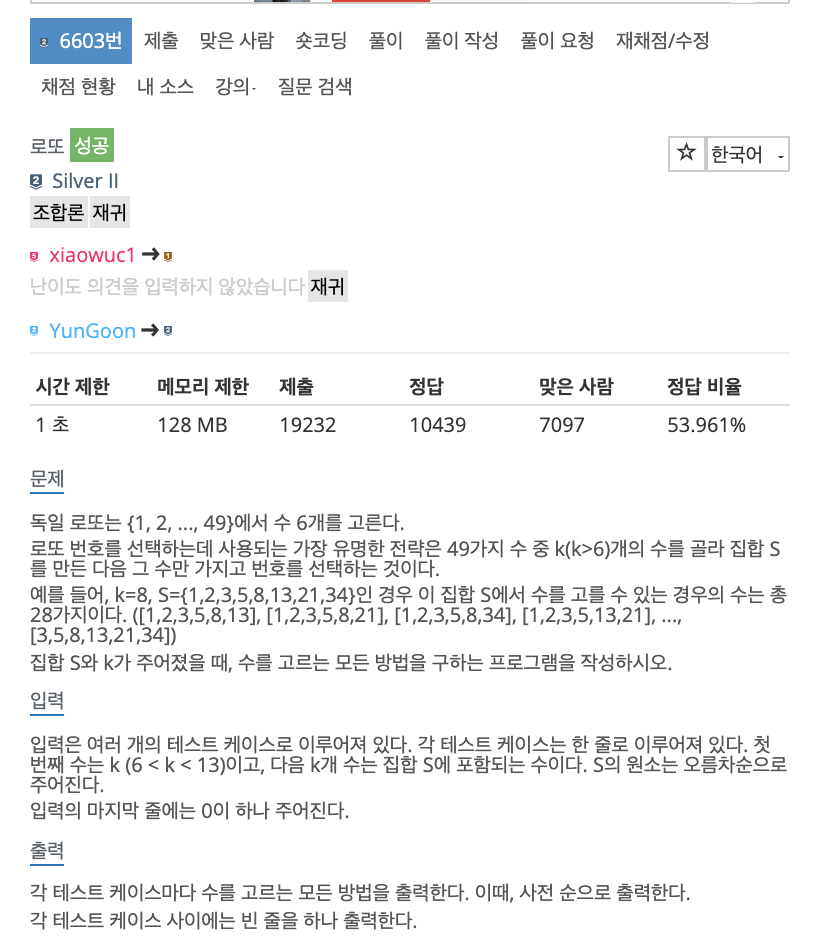#유형:탐색, 순열, DFS
# aabbbaa 같은 경우 abababa
# abc => abc acb bac bca cab cba 같이 순열을 만들어서 행운의 문자열인지 체크하면 된다.
# dfs, 순열의 개념을 알고있었다면 그렇게 어렵지 않은 문제. 시간초과만 주의해주면 된다. 맨 처음에는 순열을 호출할때마다 조건문으로 검사하거나 순열의 파라미터를 String이나 리스트로 넘겼는데, 시간초과가 났다. 그래서 우선 길이에 맞는 순열을 만들때마다 조건문으로 행운의 문자열인지 체크해줘서 count++하면 된다. 이 때 리스트의 첫 번째인덱스부터 다음 인덱스와 같으면 false를 리턴하게 하면 된다.
그리고, 이렇게 짜면 문제점이 중복값이 나온다. aabbbaa 같은 경우에 a가 4개여서 순서가 바뀌어서 중복이 발생하는데, 이 때 팩토리얼로 나눠주면 중복을 없앨수있다.
순열 https://ukyonge.tistory.com/16?category=870876

|
1
2
3
4
5
6
7
8
9
10
11
12
13
14
15
16
17
18
19
20
21
22
23
24
25
26
27
28
29
30
31
32
33
34
35
36
37
38
39
40
41
42
43
44
45
46
47
48
49
50
51
52
53
54
55
56
57
58
59
60
61
62
63
64
65
|
package bj;
import java.io.BufferedReader;
import java.io.IOException;
import java.io.InputStreamReader;
import java.util.ArrayList;
public class p1342 {
static int result=0;
static String str;
static ArrayList<Character> arrList = new ArrayList<>();
static int al[] = new int[26];
static char arr[] = new char[10];
static boolean visit[] = new boolean[10];
public static void main(String[] args) throws IOException {
BufferedReader br = new BufferedReader(new InputStreamReader(System.in));
str = br.readLine();
for(int i=0; i<str.length(); i++) {
al[str.charAt(i)-'a']++;
}
permutation(0);
for(int i=0; i<26; i++) {
if(al[i] > 1) {
result /= factorial(al[i]);
}
}
System.out.println(result);
}
public static boolean check() {
return false;
}
return true;
}
public static int factorial(int N) {
if(N==1)
return 1;
return N*factorial(N-1);
}
public static void permutation(int count) {
if(count == str.length()) {
if(check()) {
result++;
return;
}
}
for(int i=0; i<str.length(); i++) {
if(!visit[i]) {
visit[i] = true;
arrList.add(str.charAt(i));
permutation(count+1);
visit[i] = false;
}
}
}
}
http://colorscripter.com/info#e" target="_blank" style="color:#4f4f4ftext-decoration:none">Colored by Color Scripter
|
http://colorscripter.com/info#e" target="_blank" style="text-decoration:none;color:white">cs |
'백준' 카테고리의 다른 글
| #백준_3190 뱀 - Java 자바 (0) | 2020.02.02 |
|---|---|
| #백준_1120 문자열 - Java 자바 (0) | 2020.01.31 |
| #백준_1022 소용돌이 예쁘게 출력하기 - Java 자바 (0) | 2020.01.31 |
| #백준_1405 미친 로봇 - Java 자바 (0) | 2020.01.30 |
| #백준_1057 토너먼트 - Java (0) | 2020.01.29 |






